
AT 6.10pm on June 6, 1984 undercover police officer Mick Drury should have been dead — murdered by hitman Christopher Dale Flannery, with Detective Sergeant Roger Rogerson sitting in a police car nearby.
Rogerson had driven Flannery, also known as Mr Rent-a-Kill, to Drury’s Chatswood home and was listening to his police radio when Flannery squeezed the trigger twice.
“What better way of making your escape from a murder scene than in a police car with a then-respected Detective Sergeant behind the wheel,’’ Drury told The Daily Telegraph.
“I have no doubt Rogerson was there at the time I was shot.”
Two hollow point .357 slugs ripped into Drury’s stomach and upper body as he stood in the kitchen of his Chatswood home, having just fed his daughter chicken soup.
His wife Pam was breastfeeding. His other daughter was in the lounge room.
Against all odds, the decorated police officer survived.
This would prove fatal for the career of Rogerson and the life of Flannery.
Drury’s wounds were horrific, yet the attending police still asked the 28-year-old Drug Squad officer: “Who wanted you dead?”
Writhing in pain, Drury racked his brain.
“The Melbourne job,” was all he said before asking to be hit with gas to stop the pain.

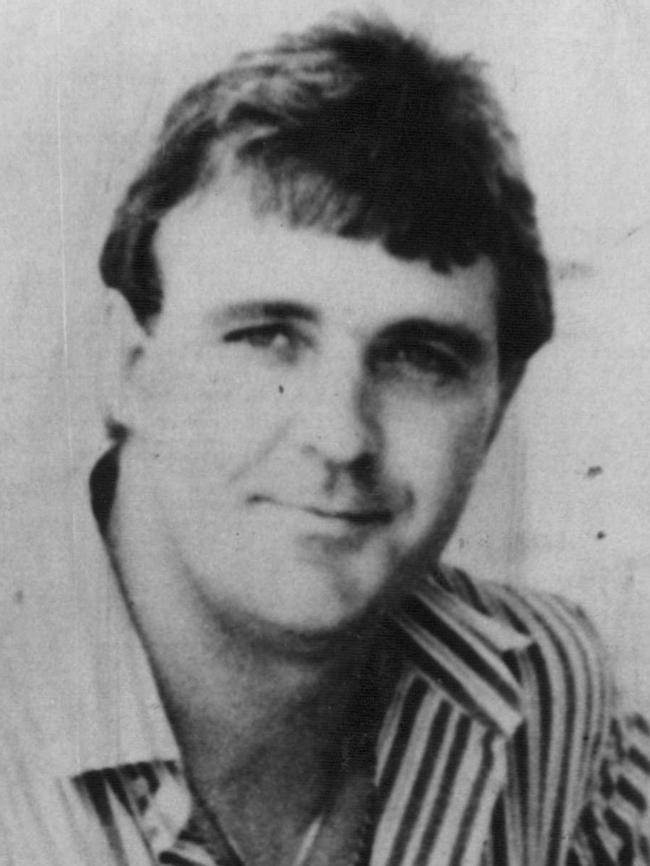
In a declaration made from his hospital bed, Drury said he had been offered $25,000 to change his evidence in the trial of Melbourne drug dealer Alan David Williams.
Drury was to be the star witness.
Williams was an old friend and cohort of Flannery and would later confess to organising the attempted murder of Drury over dinner at a Sydney restaurant with Rogerson and Flannery, who were each promised $50,000.
It would take years before Rogerson was charged with attempted murder.
And by that time his would-be co-accused, Flannery, had “vanished”.
Drury was known to be as straight as an arrow. He was the youngest detective ever drafted into the CIB.
He was also awarded the Peter Mitchell Award the year after Rogerson for his work on uncovering massive drug plantations in the Griffith area.
After he was shot, Drury was subjected to at least two other attempts on his life and had to endure an ongoing attack on his good name.
Instead of being the victim he was treated like a criminal, even as he lay in hospital.
The head of the investigation, Angus McDonald, was a friend of Rogerson.
He accused Drury of being “the biggest gangster since Al Capone’’.
“I was allegedly running a major drug network throughout North Sydney and the east coast of NSW into Queensland,” Drury said.
“I was also supposed to be running several massage parlours”.
McDonald made sure the false rumours were spread throughout the CID and the wider police community.
“He used all his energy to spread these rumours and at the same time refused to have detectives investigate Rogerson,” Drury said.
“To me it was a conspiracy to pervert the course of justice and others at a higher level were complicit.”
Days after the shooting, Flannery was discovered lurking about Royal North Shore Hospital — where Drury was under police guard in a critical condition.
The place was swarming with cops and Flannery left knowing he hadn’t finished the job — but confident Drury would die.
Williams had already paid $50,000 upfront, of which Rogerson pocketed $45,000 and Flannery $5000.
Months after being released from hospital Drury and his family went to Newcastle for three days to recuperate.
It was the first time the house was left unguarded by police.
In that time initials were engraved with a small screw driver and a rubber mallet under the kitchen window that was shot through.
It was a clear message the killer’s work was not done and they knew Drury’s every move.
And it couldn’t have been done without inside information from police.
In the decades since the shooting Drury has never publicly spoken about Rogerson except in court.
Even now, a crying baby in a shopping centre or cafe will bring back those memories when he was crawling on the floor trying to hold his insides in as he yelled at his wife to ring 000 and take the kids into the bedroom.
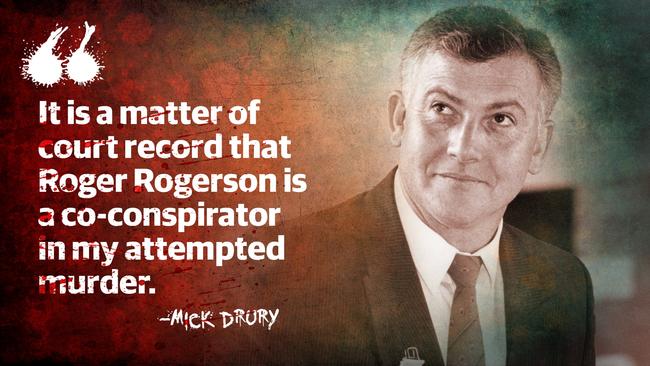
Williams was eventually charged by Chief Superintendent Doug Kelly and others from the Omega Task force with conspiring to murder Drury.
“It can never be forgotten, Alan Williams stood in the dock of the Supreme Court and pleaded guilty to conspiring with Christopher Dale Flannery and Roger Caleb Rogerson to murder Michael Patrick Drury on the 6/6/1984 at Chatswood,” Drury said.
“To me it cannot be understated the gravity of a man pleading guilty to an indictment that carries a life sentence.
“It is a matter of court record that Roger Rogerson is a co-conspirator in my attempted murder.’’
Several months after his guilty plea, Williams asked to talk Drury so he could apologise for what happened.
A magnanimous Drury agreed and went to police headquarters where he was led into a room with Doug Kelly.
“I told Alan Williams while I will never forget what he was party to I said I could forgive him for telling the truth,” Drury said.
“And before hanging up I said, ‘Look after yourself and take care in jail’.”
A senior officer still serving in the NSW Police spoke to Williams after he was arrested while on the run in Northern Territory for the attempted murder of Drury.
“When he was relaying how matter of fact Roger spoke about killing another cop I felt physically sick. Like every other young guy in the force Rogerson was a kind of hero. Now knowing what I know about him, I think he is a piece of shit and that’s being disrespectful to shit,’’ the officer said.
Another senior officer who interviewed Rogerson when he was in jail during one of the many reinvestigations into the murder of Sally-Anne Huckstep spoke of how disarming he could be.
“After about 20 minutes of talking to him I thought, ‘He’s not a bad bloke’ then had to remind myself I was interviewing him in jail about one of a number of murders we thought he may be connected to,’’ the officer said.
Another cop who hated Rogerson during his days in the Armed Hold Up Squad, but respected him for his police work, said he never believed he could have had Drury shot.
“Then I was out at Long Bay (prison) and told a guard what I thought,” he said.
“The guard took me to a small dark cell in a secret part of the jail for super protected witnesses.
“It was Alan Williams. After talking to him I was convinced Roger organised it.’’
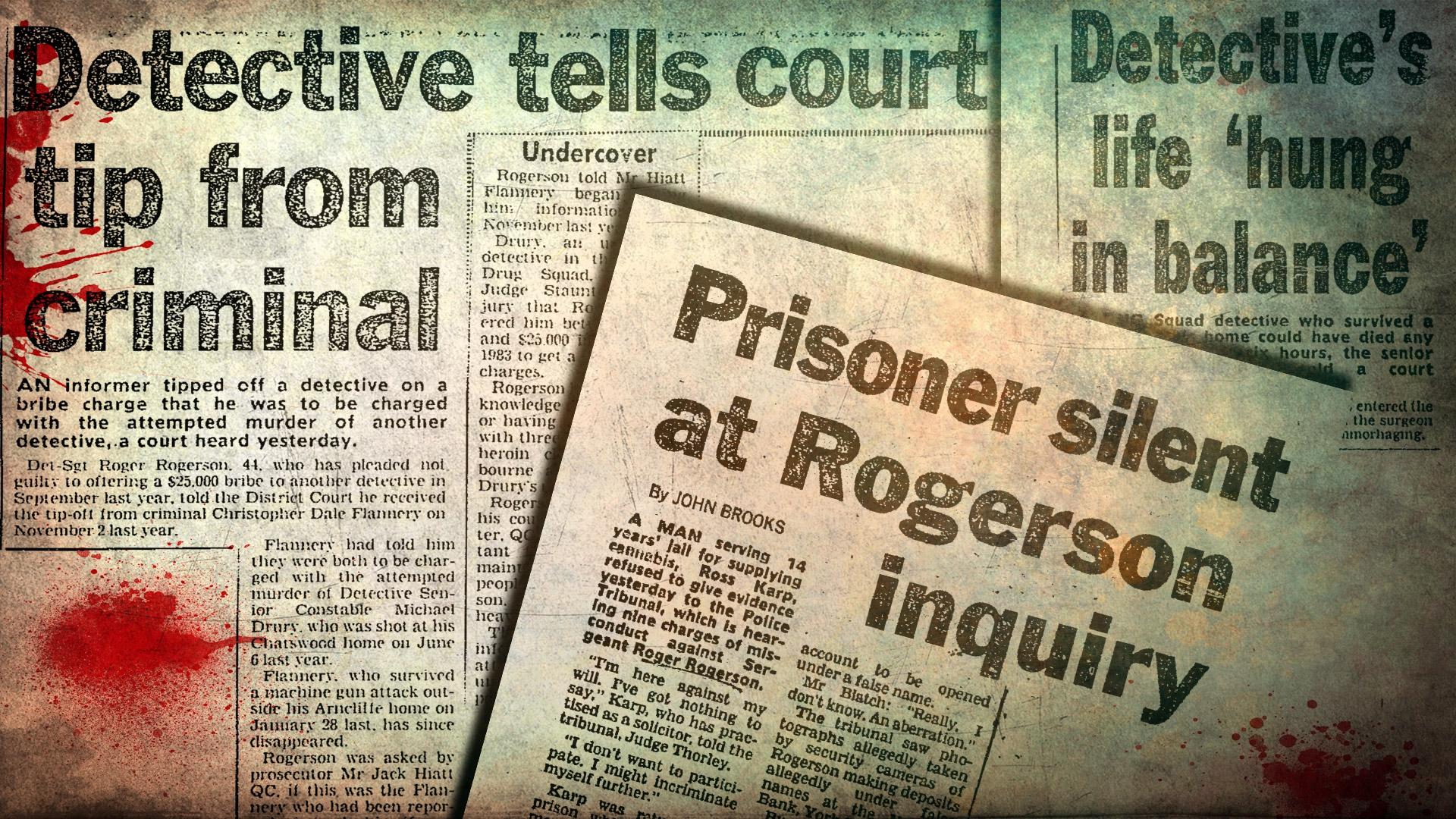
The first investigation into the Drury shooting conducted by McDonald, known as “Black Angus”, was later ripped to shreds as inept and a possible whitewash.
It pointed to the reluctance of McDonald to interview Rogerson and the fact he was a known supporter of the detective.
The report also made references to the appalling treatment of accusing Drury of corruption when he was in hospital trying to recover.
Despite this, Rogerson was charged by summons in November 1985 with attempting to bribe Drury.
At the time, he reportedly threw his beloved badge into a garbage bin before storming out of police headquarters.
In June the next year, with Sydney’s gangland wars raging, Rogerson was found not guilty of the bribery charge.
After the verdict, Drury stunned everyone when he shook hands with Rogerson on the courthouse steps.
“I did it for a number of reasons,’’ Drury said.
“The main reason was I wanted to send the message to him it was over. To look him in the eye and say, ‘That’s it.’ I wanted my family to be safe.”
A subsequent reinvestigation of the Drury shooting was conducted by Chief Inspector Bruce Kerrison, who was hand-picked by new police Commissioner John Avery.
Kerrison’s work led Avery to establish an elite task force in July of 1987 named Omega to pursue the shooting of Drury.
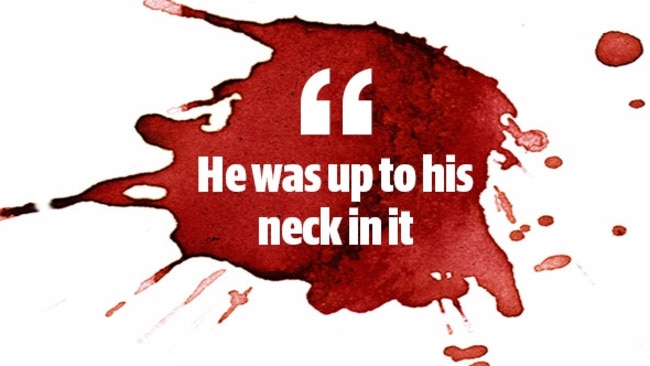
It was led by Chief Superintendent Doug Kelly and aided by a rising star in the force, Inspector Clive Small.
Small was also the lead investigator in the capture of Ivan Milat.
Small and Kelly interviewed Kath Flannery, the wife of the missing hit-man, and learnt that Rogerson was a regular visitor at their home. So was Alan Williams.
She also told them on the night of the Drury shooting Rogerson was at the Scots Club in Arncliffe with her husband. She had met them there.
Rogerson admitted to being at the club, but said he left at about 6.30pm to go home.
This would have given him no time to be at the shooting.
The times were blurry and impossible to verify.
When Williams eventually spilt his guts to Small he well and truly put Rogerson at the scene.
In his sworn statement, Williams said when the decision to kill Drury was made Rogerson left the table of the Polettis restaurant to go to the toilet.
Williams was jittery about having a cop involved.
“I’ll make sure he is with me,’’ Flannery had said.
In 1988, after more than a year of intense investigation and armed with the Williams confession, Rogerson was arrested and charged with the attempted murder of Drury.
No one could ever remember a police officer being charged with trying to kill another policeman for profit.
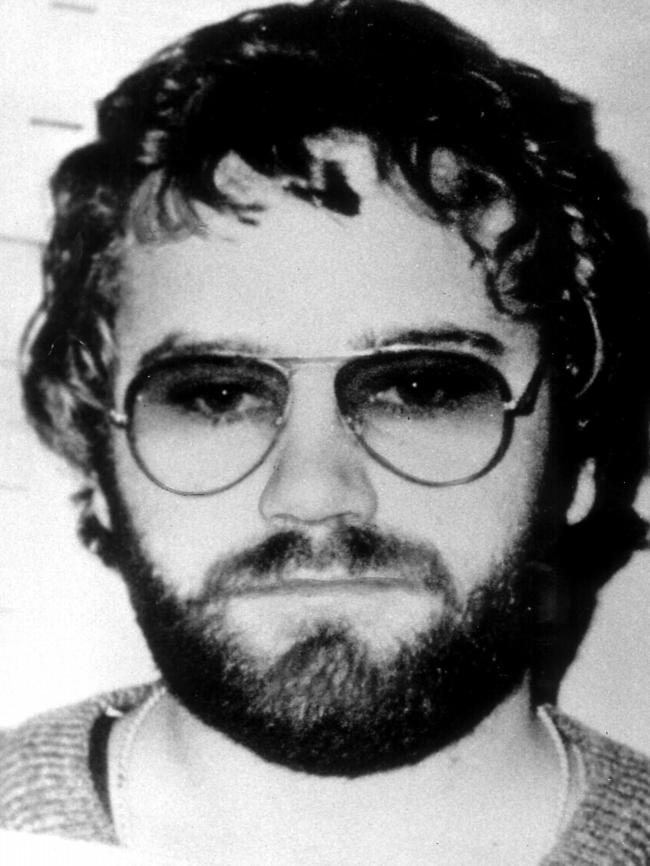
Before the trial of the decade, pitting cop against cop, the prosecution was delivered a huge blow.
The allegation Rogerson had attempted to bribe Drury could not be used in court.
Greg James QC successfully argued his client had already been acquitted of those charges.
This hampered young prosecutor Chris Maxwell.
Even still, the trial gripped Sydney.
Drury was forced to relive the shooting – but felt hampered by not being able to refer to Rogerson’s approaches to throw the drug case against Williams.
“It made it very difficult,’’ Drury said.
Drury was also forced to admit that as an undercover police officer he was adept and trained at lying and deceiving people.
Then for four days Rogerson calmly answered everything.
The truth is that Rogerson loves the witness box. And he loves going head to head with lawyers.
The charismatic Rogerson won over the jury.
On November 20, he walked from court a free man.
The taskforce and friends of Drury were devastated.
Thankfully he was able to get over the shattering decision and went on to have a distinguished police career retiring in 2000.

Despite being suspended and accused of trying to kill a cop, Rogerson and his number one informer Neddy Smith played a major part in the bloodiest gang war in Sydney for decades.
Over the next two years up to 10 gangland killings or disappearances were carried out and Rogerson was up to his neck in it.
In 1990 Small received a phone call from then deputy commissioner Col Cole.
Cole was warning him that Rogerson’s was going to kill him.
They wanted to put a 24-hour guard on him and his family.
“I wasn’t keen on that sort of intrusion in our lives even though I knew what he was capable of,” he told The Daily Telegraph.
“I sorted out some of my own security and was allowed to have a police car 24 hours a day.”
Small, a decorated officer of 40 years, said he once had the chance to raise the allegations with Roger.
“He kind of made a joke about falling off a roof (which he did do) and injuring his shoulder, which stopped him (from killing me),’’ he said.
“He then went on to talk about the bush near my house in enough detail to make me realise he knew the layout of where I lived.’’
Small has no doubt Rogerson was involved in a number of the murders in the 80s, which saw Syndey likened to the wild days of Chicago.
“He was up to his neck in it,’’ Small said.
“Neddy and Flannery wanted to take over Sydney’s crime landscape and Roger was there with them — always in the background, but he was with them every step of the way.’’
With the Drury investigation hanging over his head Rogerson was keeping a low profile.
Not so much his underworld mates Smith and Flannery.
The Sydney gangland wars started with the murder of drug dealer and major punter Danny Chubb. He was shot dead in broad daylight after buying fish and chips during a visit to his mother in Millers Point.
For Neddy, the murder solved a problem and gave rise to an opportunity.
He owed Chubb a lot of money and he could take over his business.
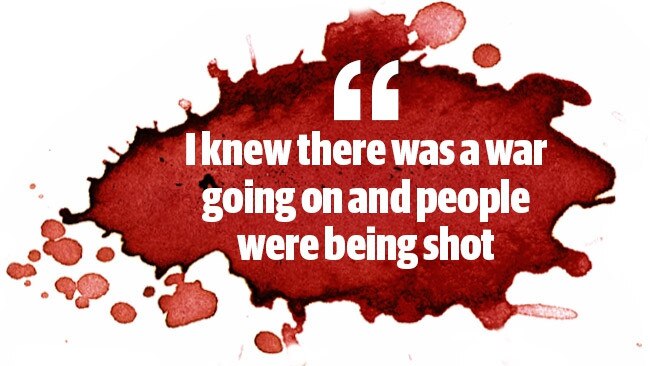
Next to go was Mick Sayers, a mate of Flannery’s when they were both in Melbourne who had racked up a huge debt to Sydney crime king George Freeman.
Freeman had taken on Flannery as debt collector and muscle man on the advise of several people, including Rogerson.
Rogerson was tight with Freeman having come in contact when he was an up and coming gangster in the 70s, as well as knowing Lennie McPherson — who also controlled most of Sydney crime with Freeman.
Over the next two years the battle raged between two groups.
Barry McCann’s gang which allegedly included Tom Domican, Kevin Theobald and Victor Camilleri.
Domican denies he was involved in any way and now lives overseas.
The war for control of illegal gambling joints and the heroin trade got personal when Flannery broke the jaw of McCann s wife during a drinking binge at the Lansdowne Hotel in Broadway.
Flannery was shot at a couple of times as the two gangs traded shots on Sydney streets.
In between the shootings, Flannery was used as a debt collector by Dr Geoffrey Edelstein on the recommendation of one of his patients — Rogerson.
But Flannery was becoming a problem.
He was trigger happy, using cocaine and wildly unpredictable.
A meeting of Sydney’s criminal powerbrokers was allegedly held at the home of Kings Cross identity Loius Bayeh.
Rogerson (godfather to one of Bayeh’s children), Freeman, McPherson and another hit man Stan Smith were there.
As were McCann and some of his trusted lieutenants.
Rogerson’s mate and former NSW detective Bill Duff was also allegedly there.
“I wasn’t at any meeting, but I knew there was a war going on and people were being shot,’’ Duff told The Daily Telegraph.


“But I knew Chris Flannery and I told him to get out of town. I also told his wife Kath that Chris was in danger. It was a bloody time and I knew he wasn’t safe. Also if he left and went back to Melbourne things might settle down.’’
Duff, sacked from the force in 1986, was often linked to Rogerson.
“Roger and I lived near each other and socialised but I never worked with him or got involved with his other activities,” he said.
“To me he was a brilliant investigator in the early days but we had some pretty big falling outs over the years. It’s only in last few years we have seen a bit of each other because of some common friends at a local pub we go to.’’
At the meeting McCann said peace could only be achieved if Flannery was dead.
When I once asked Rogerson over a beer what happened to Flannery, he leaned over and said:
“When they get out of control they have to go”. He then gave me a wink.
On May 9, 1985 Flannery left his city apartment in the then luxurious Connaught after being called to a meeting at Freeman’s Yowie Bay home.
Flannery was never seen again.
Small said he has no doubt Flannery was taken to Freemans house and executed by Stan Smith. Several retired detectives and senior law enforcement officers also believe this scenario.
The disappearance of Flannery got rid of a major problem for Rogerson.
He was the only man who could corroborate Williams’ story about the attempted murder of Drury.
The war ended with the murder of McCann on December 28, 1987.
In between drug dealers Brian Sandry, Barry Croft and a few others were also killed or went missing.
Nearly all the cases remain unsolved.
McCann’s body was later found in a Marrickville Park with 25 bullets in it.
Neddy Smith was charged with murder, but later acquitted.

Here’s what you can expect with tomorrow’s Parramatta weather
As spring moves into summer what can locals expect tomorrow? We have the latest word from the Weather Bureau.
Here’s what you can expect with tomorrow’s Parramatta weather
As spring moves into summer what can locals expect tomorrow? We have the latest word from the Weather Bureau.